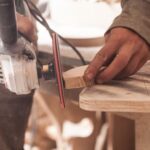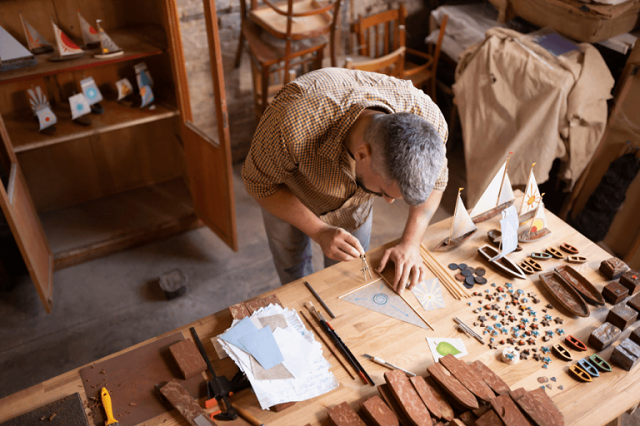Woodworking is a craft that has been around for centuries, involving the creation of items from wood through various techniques such as carving, cutting, and shaping. But is woodworking a physical hobby? In this article, we will delve into the physical demands of woodworking, the health benefits it offers, common injuries associated with the craft, safety tips, and its impact on physical fitness.
Woodworking can be a physically demanding activity, requiring the use of hand tools and power tools that involve lifting heavy materials and working with precision. The physical aspect of woodworking is not only essential to completing projects but also contributes to the overall health and well-being of enthusiasts. Engaging in woodworking can improve hand-eye coordination, muscle strength, and overall physical wellness.
However, like any physical activity, woodworking comes with potential risks and injuries. It is important to identify these risks and take precautions to prevent them. In the following sections, we will discuss common injuries in woodworking and provide practical advice on how to stay safe and maintain physical health while pursuing this rewarding hobby. So let’s explore how woodworking contributes to physical fitness and well-being while also considering modifications for individuals with physical limitations.
The Physical Demands of Woodworking
Woodworking is a highly physical hobby that requires a significant amount of strength, endurance, and coordination. Whether you are lifting heavy materials, using hand tools for precision work, or operating power tools for larger projects, the physical demands of woodworking are undeniable. It is important for anyone considering woodworking as a hobby to understand the physical aspects involved and how they impact overall health and fitness.
Lifting Heavy Materials
One of the most physically demanding aspects of woodworking is the need to lift heavy materials. Whether it’s sheets of plywood, large pieces of lumber, or even the finished product itself, woodworkers often find themselves moving heavy objects around their workspace. This requires not only strength but also proper lifting technique to avoid injury.
Using Hand Tools
Woodworking also involves the use of a variety of hand tools, such as saws, chisels, planes, and hammers. These tools require precise movements and fine motor skills to use effectively. Woodworkers often spend hours using these hand tools, which can lead to muscle fatigue and strain if proper technique is not practiced.
Working With Power Tools
In addition to hand tools, power tools are also commonly used in woodworking. These tools, such as table saws, routers, and drills, require strength and control to operate safely and effectively. They can also pose a risk for accidents if not used with caution.
Overall,is woodworking a physical hobby that demands both physical strength and stamina as well as limb coordination – making it an excellent way to exercise while creating something beautiful out of wood. Taking into account some basic tips for staying safe when working with wood can ensure that individuals may continue on this fulfilling activity without fear of injuries or over exhaustion.
Health Benefits of Woodworking
Woodworking is a physical and mentally engaging hobby that has been around for centuries. It involves creating objects from wood using various tools, techniques, and skills. The practice of woodworking dates back to ancient civilizations where it was used to construct buildings, furniture, and other functional items. Today, woodworking has evolved into a popular hobby for individuals of all ages to express their creativity and create unique pieces.
Improved Hand-Eye Coordination
One of the key physical benefits of woodworking is the improvement of hand-eye coordination. Working with hand tools or power tools requires precision and control, which can enhance dexterity and fine motor skills. In order to carve or shape wood accurately, woodworkers must develop a keen sense of spatial awareness and hand-eye coordination, leading to improved overall motor skills.
Muscle Strength
Engaging in woodworking also offers the benefit of muscle strengthening. Woodworking activities often involve lifting heavy materials, such as timber or plywood, as well as repetitive motions when cutting or sanding wood. These actions can significantly contribute to building muscle strength in the arms, shoulders, and core areas. Additionally, consistent woodworking workouts can yield both physical endurance and stamina over time.
Overall Wellness
Beyond specific improvements in hand-eye coordination and muscle strength, woodworking can positively impact an individual’s overall wellness. Engaging in such a hands-on activity provides a productive outlet for stress relief while also promoting mental focus and mindfulness during the creation process. Furthermore, the satisfaction of completing a woodworking project adds to an individual’s sense of accomplishment that contributes to emotional well-being.
Woodworking is indeed a physical hobby that offers numerous health benefits including improved hand-eye coordination, enhanced muscle strength, and overall wellness. With proper safety precautions in place, individuals can enjoy this gratifying pursuit while reaping the physical rewards it yields. Whether it involves utilizing traditional hand tools or modern power tools, woodworking provides an opportunity for individuals to stay active while pursuing their passion for creating wooden masterpieces.
Common Injuries in Woodworking
Woodworking is indeed a physical hobby that comes with its own set of risks and potential injuries. It is important for individuals pursuing woodworking to be aware of these risks and take necessary precautions to prevent them. Here are some common injuries associated with woodworking and how to avoid them:
1. Cuts and lacerations: When working with sharp tools and equipment, the risk of cuts and lacerations is high. It is crucial to always handle sharp objects with care and use protective gloves when handling materials.
2. Eye injuries: Woodworking often involves sawing, sanding, and drilling, which can produce a lot of fine dust and debris. Wearing safety goggles can help protect the eyes from potential injuries caused by flying particles.
3. Musculoskeletal strains: Woodworking involves lifting heavy materials, bending, reaching, and working in awkward positions, which can lead to strains and muscle injuries. It is important to practice proper lifting techniques, take regular breaks, and stretch to avoid musculoskeletal strains.
In order to prevent these injuries while woodworking, it is essential to follow some safety precautions:
– Always wear appropriate personal protective equipment (PPE) such as gloves, safety goggles, ear protection, and a dust mask.
– Keep work areas clean and organized to avoid tripping hazards.
– Take frequent breaks to rest your body from repetitive tasks.
– Use tools with safety features such as blade guards on saws and push sticks for using table saws.
By being mindful of the potential risks associated with woodworking and taking necessary precautions, enthusiasts can continue enjoying this physical hobby while minimizing the chances of injury.
Tips for Staying Safe and Healthy
Woodworking is indeed a physical hobby, requiring individuals to engage in various activities that demand strength, coordination, and endurance. Whether you’re lifting heavy materials, using hand tools, or operating power tools, it’s essential to consider the physical demands of this craft and take steps to stay safe and healthy while pursuing it as a hobby.
To ensure your safety and physical well-being while woodworking, here are some practical tips to keep in mind:
- Wear appropriate protective gear: Always wear safety goggles, ear protection, and a dust mask to protect your eyes, ears, and respiratory system from potential hazards such as sawdust and loud noises.
- Take regular breaks: Woodworking can be physically demanding, so it’s important to take frequent breaks to rest your muscles and prevent fatigue or overexertion.
- Use proper lifting techniques: When handling heavy materials or equipment, make sure to bend at the knees and use your leg muscles rather than your back to lift objects safely.
In addition to these tips for staying safe while woodworking, it’s also crucial to maintain your physical health in order to enjoy this hobby to the fullest. Here are some guidelines for maintaining physical wellness:
- Stay hydrated: Drink plenty of water throughout your woodworking sessions to stay properly hydrated and support overall bodily function.
- Stretch before and after woodworking: Engage in gentle stretching exercises before starting your woodworking projects and after completing them to prevent muscle strain and promote flexibility.
- Practice good posture: Pay attention to your posture while working on woodworking projects to avoid back pain or other musculoskeletal issues.
By following these practical tips for staying safe and maintaining physical health while pursuing woodworking as a hobby, enthusiasts can enjoy the craft while minimizing the risk of injuries. Taking proactive measures will not only enhance safety but also contribute positively to overall physical fitness.
Physical Fitness and Woodworking
Woodworking is indeed a physical hobby that requires strength, endurance, and flexibility. It involves a variety of physical tasks, including lifting heavy materials, using hand tools like chisels and saws, and operating power tools such as drills and sanders. These activities can contribute to improved muscle strength, coordination, and overall physical wellness. Furthermore, the repetitive nature of woodworking tasks can also promote flexibility and dexterity in the hands and fingers.
In addition to the physical demands of woodworking, it is important to consider the impact of this hobby on cardiovascular health. While woodworking may not be as intense as traditional forms of exercise like running or weightlifting, it still involves moderate levels of physical activity. For instance, moving around a workshop, lifting and carrying materials, and engaging in various woodworking tasks can elevate heart rate and contribute to cardiovascular fitness.
Flexibility is another key aspect of physical fitness that is influenced by woodworking. Woodworkers often need to maneuver in tight spaces, reach for tools or materials in awkward positions, and maintain proper posture while working on projects. These movements require flexibility in the muscles and joints, which can be developed and maintained through regular woodworking activities.
| Aspect | Impact |
|---|---|
| Physical Demands | Strengthens muscles |
| Cardiovascular Health | Promotes moderate levels of physical activity |
| Flexibility | Develops flexibility in muscles and joints |
Modifications for Physical Limitations
Woodworking is indeed a physical hobby, requiring a certain level of strength and dexterity to work with heavy materials and hand tools. However, individuals with physical limitations can still enjoy this craft by making some modifications to their techniques. Whether it’s due to age, injury, or disability, there are several ways to adapt woodworking practices to accommodate different physical needs.
One important modification for individuals with physical limitations is the use of ergonomic tools and equipment. These specialized tools are designed to reduce strain on the body and make woodworking more accessible for those with limited strength or mobility. For example, using lightweight and easy-grip tools can help individuals with arthritis or weakened muscles continue their woodworking activities without exacerbating their condition.
In addition to ergonomic tools, making adjustments to the workspace is crucial for those with physical limitations. This may include setting up a workbench at an appropriate height to reduce the need for bending or reaching, as well as ensuring that the woodworking area is well-lit and free of obstacles. By creating a safe and comfortable environment, individuals with physical limitations can fully engage in woodworking without putting themselves at risk of further injury.
It’s also important for individuals with physical limitations to pace themselves and take breaks as needed while engaging in woodworking activities. This will help prevent overexertion and minimize the risk of strain or injury. By listening to their bodies and practicing self-care during woodworking sessions, individuals can continue to pursue this hobby in a way that is both enjoyable and safe.
| Modification for Physical Limitations | Examples |
|---|---|
| Use of ergonomic tools | Lightweight hand tools, easy-grip handles |
| Workspace adjustments | Workbench at appropriate height, well-lit area |
| Pacing and taking breaks | Taking breaks as needed, avoiding overexertion |
Conclusion
In conclusion, woodworking is indeed a physical hobby that offers a wide range of health benefits. From the physical demands of lifting heavy materials and using hand and power tools to the improvement of hand-eye coordination, muscle strength, and overall wellness, woodworking provides a unique opportunity for individuals to engage in a rewarding and physically stimulating activity.
Despite the potential for common injuries associated with woodworking, such as cuts, splinters, and strains, there are practical ways to prevent them. By following safety guidelines and using proper techniques, individuals can minimize their risk of injury and enjoy woodworking safely.
Furthermore, the connection between physical fitness and woodworking is evident. Engaging in this craft can have positive effects on cardiovascular health and flexibility. Even individuals with physical limitations can still partake in woodworking by making modifications to adapt their techniques.
Overall, the combination of creativity and physical activity makes woodworking a fulfilling and beneficial hobby for individuals of all ages. Whether you are an experienced woodworker or just starting out, the physical aspects of this craft offer numerous advantages for your overall well-being.
Frequently Asked Questions
What Kind of Hobby Is Woodworking?
Woodworking is a hands-on hobby that involves the crafting, carving, and shaping of wood to create functional or decorative items. It requires skill, precision, and creativity to work with various tools and materials.
Can Woodwork Be a Hobby?
Absolutely, woodworking can be a fulfilling hobby for anyone with an interest in working with their hands and creating something tangible. Many people enjoy the process of planning, measuring, cutting, and assembling pieces of wood into unique projects.
What Is Woodworking Considered?
Woodworking is considered both a craft and a hobby. As a craft, it involves mastering techniques and skills to produce high-quality items. As a hobby, it offers individuals an outlet for creativity and relaxation while working with wood as a medium for self-expression.

Hi everyone! I’m a woodworker and blogger, and this is my woodworking blog. In my blog, I share tips and tricks for woodworkers of all skill levels, as well as project ideas that you can try yourself.





